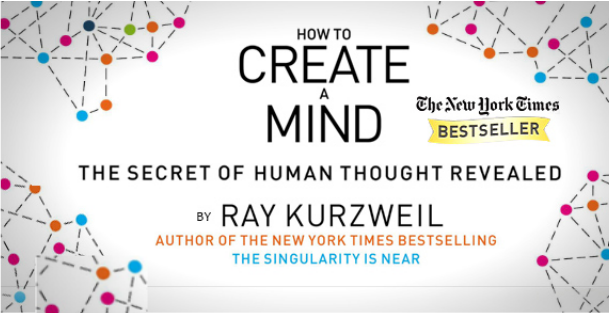

“Kurzweil writes boldly and with a showman’s flair, expertly guiding the lay reader into deep thickets of neuroscience.” – Kate Tuttle, Boston Globe
“It is rare to find a book that offers unique and inspiring content on every page. How to Create a Mind achieves that and more. This is a visionary work that is also accessible and entertaining. – Rafael Reif, president, MIT
“Ray Kurzweil’s understanding of the brain and artificial intelligence will dramatically impact every aspect of our lives, every industry on Earth, and how we think about our future. If you care about any of these, read this book!” – Peter H. Diamandis
Ray Kurzweil is probably the boldest, most famous, and controversial of the futurists today. In his new book, How to Create a Mind, he tackles such difficult subjects as the nature of consciousness, the creation of artificial intelligence, metacognition, and reverse-engineering the human brain.
Kurzweil’s central thesis is the Pattern Recognition Theory of Mind based on hierarchical models – it is this feature, he says, that makes the mammalian brain unique. What this means is that our memories and knowledge of the world are stored as sequences of neural patterns. And we recognise a pattern in hierarchical sequence, even if only a part of it is perceived. (This is also the basis of auto-text-correct on your iPhone).
Kurzweil starts the book by giving the reader an overview of the neocortex—the part of the brain that is evolutionarily more recent and unique to mammals. He points out that there are half a million cortical columns in the human neo-cortex. Each pattern recogniser within a cortical column contains about 100 neurons. This means there are over 300 million pattern recognisers in the neocortex—more than enough to develop language and tools—with redundancies to spare.
Related to the hierarchical model of pattern recognition is the idea of ‘recursion’ – which is the brain’s ability to put together small parts into a larger chunk and then use that chunk as a part in yet another structure and to continue this iteratively. What makes our brain even more fascinating is its ability to recognise patterns even when aspects of the pattern are transformed. (Consider how we can recognise a picture of Einstein or Marilyn Monroe even after it has been grotesquely modified). Kurzweil goes on to explain this ability of the brain (called ‘feature invariance’) in the early part of the book.
Along the way, Kurzweil talks about the creation of a biologically inspired digital neocortex; Henry Markam’s Blue Brain Project; and David Dalrymple’s attempt to simulate a digital brain. Markram is confident that in ten years we will be able to build a human brain. Kurzweil predicts that exponential growth in brain scanning and imaging techniques will allow us to successfully reverse-engineered the human brain by 2029.
Over the course of the book, Kurzweil offers insightful commentary on various aspects of creating artificial intelligence including Hierarchical Hidden Markov Models, LISP (List Processor), and Sparse Coding. He also spends several pages extolling the advances we’ve already made on the artificial intelligence front. He reminds us of the wonder of IBM Watson’s astonishing accomplishment in beating the world’s best human contestants at Jeaopardy! What makes Watson more impressive than IMB Deep Blue is Watson’s ability to understand something as sophisticated and intricate as human language. The knowledge it accessed to win Jeopardy!was, for the most part, not code-written. Watson actually acquired much of its knowledge by actually “reading” 200 million natural language documents online.
Artificial intelligence is already all around us, Kurzweil reminds us: intelligent algorithms that route emails and cell phone calls; electrocardiogram diagnoses; blood cell imaging; detecting credit card fraud; flying airplanes; intelligent weapons systems; playing chess; voice recognition; self-driving cars, and much more…
The ultimate goal of the book or Kurzweil’s aim in life is to see the successful reverse-engineering of the human brain. This may well be the most important project in the universe. But the question we need to ask ourselves is, once we create a simulated brain or an artificial mind, what would its purpose be? This is a question we need to grapple with sooner rather than later, because the day is not far when non-biological brains will start to outperform biological brains and the two integrate.